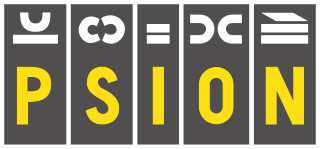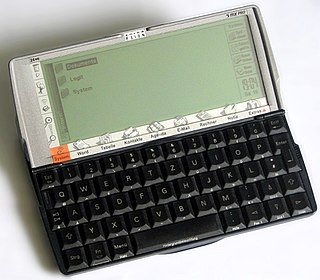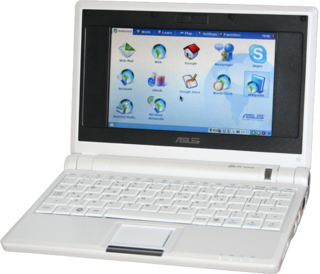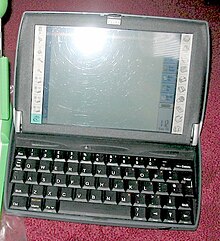Amstrad was a British electronics company, founded in 1968 by Alan Sugar at the age of 21. The name is a contraction of Alan Michael Sugar Trading. It was first listed on the London Stock Exchange in April 1980. During the late 1980s, Amstrad had a substantial share of the PC market in the UK. Amstrad was once a FTSE 100 Index constituent, but since 2007 has been wholly owned by Sky UK. As of 2006, Amstrad's main business was manufacturing Sky UK interactive boxes. In 2010, Sky integrated Amstrad's satellite division as part of Sky so they could make their own set-top boxes in-house.

Psion PLC was a designer and manufacturer of mobile handheld computers for commercial and industrial uses. The company was headquartered in London, England, with major operations in Mississauga, Ontario, Canada, and other company offices in Europe, the United States, Asia, Latin America, and the Middle East. It was a public company listed on the London Stock Exchange and was once a constituent of the FTSE 100 Index.

The United States Patent and Trademark Office (USPTO) is an agency in the U.S. Department of Commerce that serves as the national patent office and trademark registration authority for the United States. The USPTO's headquarters are in Alexandria, Virginia, after a 2005 move from the Crystal City area of neighboring Arlington, Virginia.

The Psion Series 5 was a personal digital assistant (PDA) from Psion. It came in two main variants, the Series 5 and the Series 5mx (1999), the latter having a faster processor, clearer liquid crystal display (LCD), and updated software. There was also a rare Series 5mx Pro, which differed only in having the operating system (OS) loaded into random-access memory (RAM) and hence upgradeable. Ericsson marketed a version of the Series 5mx renamed as MC218.

A netbook is a small and inexpensive laptop designed primarily as a means of accessing the Internet. Netbooks were sold from 2007 until around 2013, when the widespread advent of smartphones eclipsed their popularity. Netbooks generally had lower-end hardware specifications than consumer laptops of the time, being primarily intended as clients for Internet services. While netbook has fallen out of use, these machines evolved into other products including Google's Chromebook, and mobile devices, particularly tablet computers, often running mobile operating systems such as iOS or Android.

The Psion Series 3 range of personal digital assistants were made by Psion PLC. The four main variants are the Psion Series 3 (1991), the Psion Series 3a (1993), the Psion Series 3c (1996), and the Psion Series 3mx (1998), all sized 165 by 85 by 22 millimetres. Further, a Psion Series 3a variant with factory installed software for the Russian language was called a Psion Series 3aR, and Acorn Computers sold renamed versions of the Psion Series 3 and 3a marketed as the Acorn Pocket Book and Acorn Pocket Book II.
The Psion Series 7 is a subnotebook computer from Psion that was released in 2000. In size it is fairly original: larger than a palmtop or handheld machine, but smaller than a laptop computer. It was the first and last of the Psion series to have a full color electronic visual display. It has a leather-bound clamshell design, with a touch-sensitive, Video Graphics Array (VGA) resolution liquid-crystal display (LCD) and QWERTY computer keyboard. Internally it has a 132.71 MHz StrongARM SA-1100 processor, 16 megabyte (MB) of random-access memory (RAM) and 16 MB of internal read-only memory (ROM).

Xbox Linux was a project that ported the Linux operating system to the Xbox video game console. Because the Xbox uses a digital signature system to prevent the public from running unsigned code, one must either use a modchip, or a softmod. Originally, modchips were the only option; however, it was later demonstrated that the TSOP chip on which the Xbox's BIOS is held may be reflashed. This way, one may flash on the "Cromwell" BIOS, which was developed legally by the Xbox Linux project. Catalyzed by a large cash prize for the first team to provide the possibility of booting Linux on an Xbox without the need of a hardware hack, numerous software-only hacks were also found. For example, a buffer overflow was found in the game 007: Agent Under Fire that allowed the booting of a Linux loader ("xbeboot") straight from a save game.
Jiangsu Lemote Tech Co., Ltd or Lemote is a computer company established as a joint venture between the Jiangsu Menglan Group and the Chinese Institute of Computing Technology, involved in computer hardware and software products, services, and projects.
The Classmate PC, formerly known as Eduwise, is Intel's entry into the market for low-cost personal computers for children in the developing world. It is in some respects similar to the One Laptop Per Child (OLPC) trade association's Children's Machine (XO), which has a similar target market. Although made for profit, the Classmate PC is considered an Information and Communication Technologies for Development project (ICT4D). Introduced in 2006, the device falls into the then popular category of netbooks.

The ASUS Eee PC was a netbook computer line from Asus, and a part of the ASUS Eee product family. At the time of its introduction in late 2007, it was noted for its combination of a lightweight, Linux-based operating system, solid-state drive (SSD), and relatively low cost. Newer models added the options of Microsoft Windows operating system and rotating media hard disk drives (HDD), and initially retailed for up to 500 euros.
The Commodore PC compatible systems are a range of IBM PC compatible personal computers introduced in 1984 by home computer manufacturer Commodore Business Machines.

The A110 is a netbook computer by One. It is built on a reference design by Quanta Computer and was announced to run Linpus Linux. However, some or all of the first batch have actually been delivered with a modified Ubuntu Linux installed, using SquashFS to fit the system in the 2GB Flash memory.
Nvidia Ion was a product line of Nvidia Corporation intended for motherboards of low-cost portable computers. It used graphics processing units and chipsets intended for small products.
The Dell Inspiron Mini Series is a line of subnotebook/netbook computers designed by Dell. The series was introduced in September 2008 amidst the growing popularity of low-cost netbook computers introduced by competitors.
Psion Teklogix Inc. was the operational business of Psion.

The Nokia Booklet 3G was a netbook produced by the Finnish company Nokia. It was announced on 24 August 2009.

HP Mini is a former line of small computers categorized as netbooks manufactured by Hewlett-Packard. They either contained a custom version of Ubuntu Linux, Microsoft Windows XP Home Edition or Windows 7 Starter operating system. Like most netbooks, they were not built with CD/DVD drives. They were announced from mid-2007, and marketed from 2008 through 2012.

The IdeaPad S Series is a series of notebook computers launched by Lenovo in October 2008. The IdeaPad S10 was initially scheduled for launch in September, but its release was delayed in the United States until October.
EPOC is a mobile operating system developed by Psion, a British company founded in 1980. It began as a 16-bit operating system (OS) for Psion's own x86-compatible devices, and was later replaced by a 32-bit system for x86 and ARM. Psion licensed the 32-bit system to other hardware makers, such as Ericsson.










